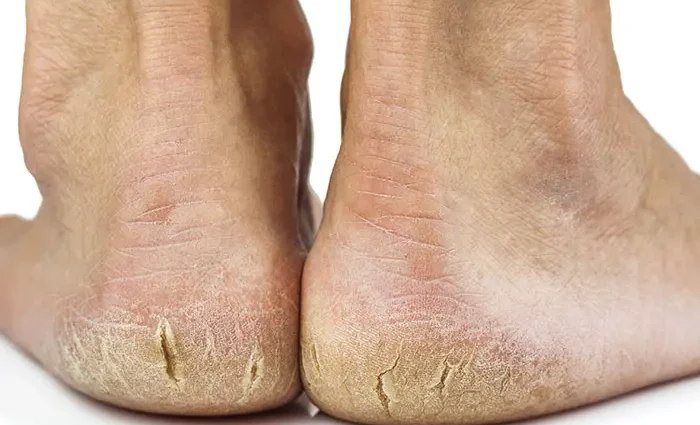Contents
Smooth heels are a dream, sometimes far from reality. Our article will help you get closer to its implementation.
Causes of dry skin and cracked heels
The worst thing that can happen to the skin on your heels is cracks. Even if they do not cause discomfort or pain, they should not be ignored. Cracks can serve as a signal of problems in the body. However, most likely, you yourself unwittingly launched the situation.
External causes
Tight, uncomfortable shoes. Shoes should protect the skin of the feet and minimize stress. Incorrectly selected shoes or boots at least disrupt blood circulation and harmonious weight distribution. The consequences are calluses and corns.
Open shoes. Have you noticed that in the summer the skin on the heels roughens and thickens especially quickly? Sandals, sandals, slates save the feet from heat and overheating, but at the same time the skin of the feet is forced to defend itself from the outside world with double zeal. That is to build up armor.
Insufficient care. The skin on the heels is prone to thickening – this is a protective reaction. If the “growths” are not exfoliated in time, cracks may form in places of the highest pressure over time.
Too active care. Yes, and you can go too far with it – peeling with special socks or using professional exfoliating devices on your own will thin the skin excessively. Hence the wounds and cracks. Plus, by removing too much skin, you stimulate tissue regeneration in SOS mode – the skin will grow quickly and in greater volume.
Fungal lesions. If there is a suspicion of a fungal infection, run to the doctor.
Thickening of the skin of the heels is a natural phenomenon.
Internal causes
We will not make diagnoses, but if you are faced with dry heels and cracks that are uncharacteristic for you, then the reason may be more serious than improper care or uncomfortable shoes.
Avitaminosis.
Dehydration of the body.
Violation of the digestive tract.
Hormonal reorganization.
Lack of fatty acids in the diet.
Daily care rules
Taking care of your feet is generally easier than taking care of your face. But since no one sees our heels most of the time, we pay little attention to them. And in vain. To keep them in exemplary condition, you need only three actions.
To clean
In the case of the feet, neglecting the elementary rules of hygiene is fraught with unpleasant consequences. But no special effort is required. Do you shower in the evening? Excellent! Use the usual gel, thoroughly lathering the feet. Just remember to thoroughly rinse off the foam and dry your feet with a towel, paying particular attention to the area between the toes.
A greasy cream or oil will solve the problem of dry heels.
Moisturize and nourish
Here you can get by with one remedy – any fairly oily (but well absorbed) body cream or a special product for the feet. Most importantly, apply it every night.
exfoliate
Use a body scrub twice a week to exfoliate dead skin cells.
Cosmetics against dry skin on the heels
We have collected for you a cosmetic minimum that will help you quickly solve the problem of dry heels.
Revitalizing cream for dry skin of the feet, CeraVe, like all brand products, it contains three essential ceramides.
Foot cream “Intensive care. Nutrition, Garnier will help keep the heels in order and take care of the healing of cracks. The active ingredient is allantoin.
Care for dry and rough skin Intensive Treatment and Moisturizer for Dry or Callused Areas, Kiehl’s – Avocado, shea butter, wheat germ oils will help soften rough and rough skin of the heels and stimulate cell regeneration.
Body Scrub “Precious Beauty Scrub”, Garnier provides exfoliation and nourishment of the skin thanks to almond, rose, macadamia, argan oils.
Balm Cicaplast Baume B5, La Roche-Posay — a magnificent composition (panthenol, madecassoside, microelements, hyaluronic acid, thermal water) will come to the aid of the skin on any part of the face and body.
Cosmetic treatments for dry feet
Beauty salons usually offer two basic foot treatments.
Classic pedicure – “wet” care with a bath and subsequent removal of keratinized skin from the heels.
Hardware pedicure carried out without the participation of water, the skin is ground and polished with the help of special nozzles.
The hardware effect is softer, which means that with very problematic heels, more sessions will be required. But the risk of injury or infection is minimized.
Very dry heels: what to do at home
Foot baths soften the skin.
Baths
Soaking will help soften the rough skin of the heels and subsequently exfoliate it effectively. Pour warm water into a suitable size container, adding a little soap and baking soda. Alternatively, you can draw water into the bath and lower your feet there. Duration – 10-15 minutes. Then use a scrub.
Compresses
Olive, coconut, shea butter – any of these vegetable oils, with regular use, gradually restores the skin of the heels. You can use them alternately or mix them. Rub the oil into the skin properly and when it is absorbed, apply an additional oil layer.
By bathing and exfoliating 2-3 times a week, you can get rid of dryness quite quickly, ”says Garnier expert dermatologist Marina Kamanina.
Pumice
Safety measures
You should not use professional tools if you are not a pedicurist. Inept handling of files and pumice can result in injuries, cuts and new cracks. If you can’t solve the problem of dry and rough heels on your own, go to the salon. After a high-quality professional pedicure, it will be easier for you to keep your feet in perfect condition without much effort and skills.










